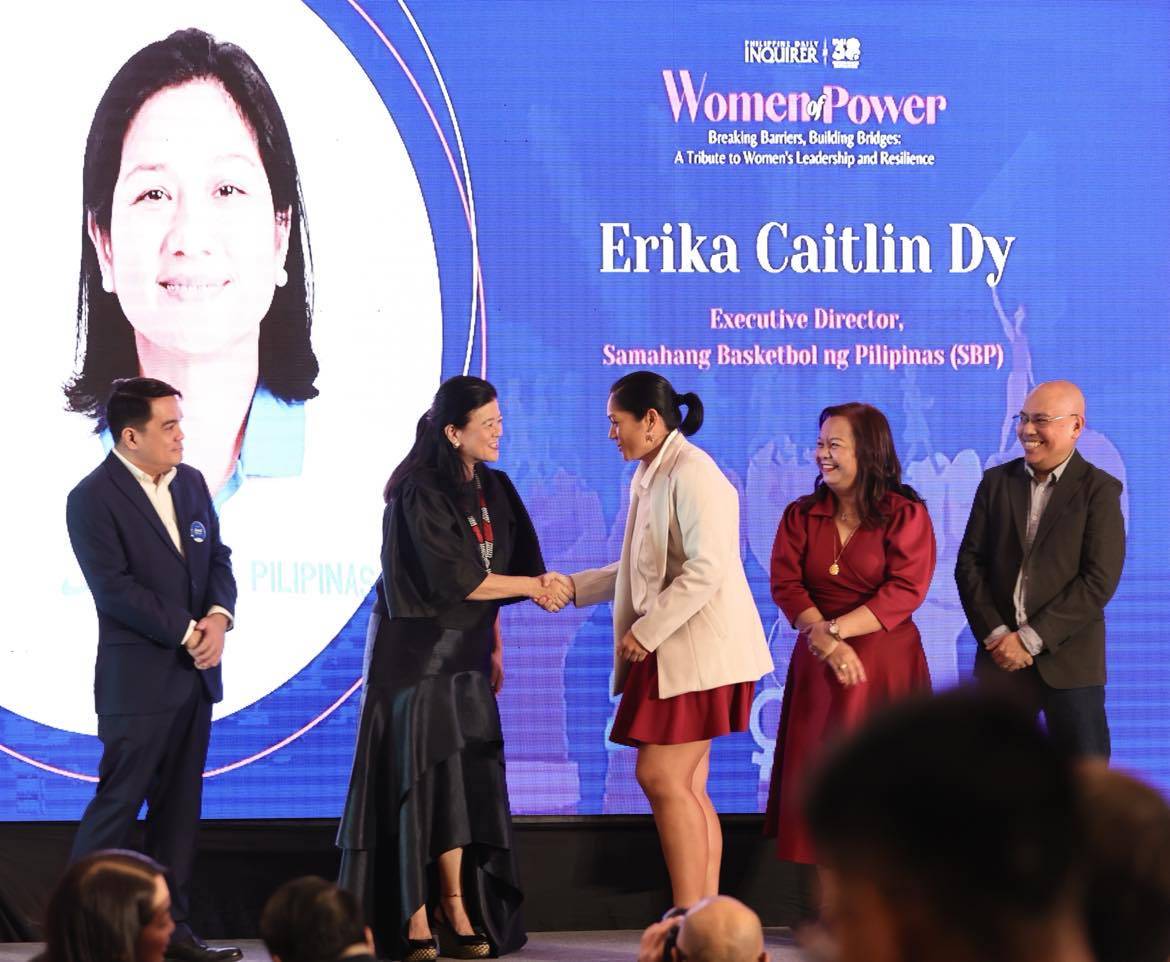
Erika Dy (third from left) is honored during the Inquirer’s Women of Power gala by (from left) lawyer Rudyard Arbolado, Philippine Daily Inquirer president and CEO, Sandy Prieto-Romualdez, Inquirer Group of Companies president and CEO, Inquirer associate publisher Juliet Labog-Javellana and Inquirer executive editor Volt Contreras. —GRIG C. MONTEGRANDE
Erika Dy knows something about starting from sweat.
As a student assistant for Columbia, Dy would mop off perspiration drops from the hardwood of the Lions’ practice facility while handing off water bottles and towels to sweat-drenched players of the US NCAA Division I school.
In a span of a few months she went from doing that to running the local organizing committee (LOC) of the Fiba (International Basketball Federation) World Cup, a tournament Manila hosted last year that was widely praised by the international basketball community for how it was managed.
READ: Erika Dy named SBP’s new Executive Director
“[Former] ED (executive director) Sonny (Barrios) was the overall head of the LOC and I was under him at that time,” Dy told the Inquirer during a Monday lunch interview. “I consulted with him a lot and all major decisions were made by him. But of course, you can’t expect him to be very hands-on so I did a lot of work [on the ground].”
The World Cup thrust Dy into the limelight and the 41-year-old lawyer, who had just finished her masters degree in sports management, (“If I were to be a sports official,” she said, “I don’t want to be appointed only because I am a former athlete but because I have knowledge about the position,”) caught the attention of the Samahang Basketbol ng Pilipinas (SBP).
An aide of the SBP’s chair emeritus Manny V. Pangilinan rang Dy in the middle of the World Cup. “If I’m not mistaken,” she said, “we were entering the final phase” when the phone call came.
READ: Gilas program picking up lessons from the past, says Erika Dy
Barrios, SBP officials told her, had tendered his resignation as executive director.
“They asked me if I was open to [taking his place],” Dy said.
It was a strange thing to be asked, especially of someone who just earlier in that same year had been passing balls to varsity players almost half her age during shooting practice. This time, the ball was in her hands. And she was being asked what she wanted to do with it.
Not a honeymoon
“I was [interested],” Dy said. “I mean, I’ve always been a basketball person. I started playing when I was seventh grade. I mean, sports in general, any sport, I appreciate. But basketball is really my first love.”
SBP president Al Panlilio appointed her to the post in an acting capacity in November. Then, in a December board meeting of the federation, she was appointed officially as the executive director, making her the most powerful woman in the country’s most beloved right now.
Her initial days on the job wasn’t exactly a honeymoon period. She had to smoothen the relationship between the national federation and the country’s passionate fan base, which felt shortchanged by the performance of the national team in the World Cup and demanded accountability.
Erika Dy (right) welcomes Team USA coach Steve Kerr during the Fiba World Cup. —PHOTO COURTESY OF ERIKA DY
The boiling hatred of the fans had cooled a bit when Gilas Pilipinas won the gold in the Asian Games last year, the first time the country ruled the continental event in over six decades. But there was a sense that all it would take was a misstep by the federation to surface those ill feelings again.
So far, the SBP has done right by the Filipino people.
The federation named Tim Cone the head coach of Gilas Pilipinas and the team won its first two games in the first window of the Fiba Asia Cup qualifiers against Hong Kong and Chinese Taipei. The day after a masterful rout of the Taiwanese at PhilSports Arena—a venue chosen specifically because of its roots in basketball history and as an ode to the sport’s fandom—Dy gave the staff of the SBP the day off.
“They finished pulling out of the venue at around 6 a.m. already,” she said.
Mileposts
Inside the near-empty office, she, too, took time and space to come up for air.
Munching on takeout Thai food, Dy had a chance to think about the mileposts she put up for herself. She wants to strengthen the women’s game here and keep the momentum that the Gilas women have generated going. Sponsors and tournaments, she said, are going to be the key. If that doesn’t pan out, the SBP can work to find leagues abroad where they can sign the Nationals up during off-window periods.
She also wants to put more women coaches on the sidelines. Even amid the rising popularity of the UAAP women’s tournament, she noted, the head coaches are predominantly men. When she coached Ateneo before, the situation was no different.
She smiled as she took note of one particular measurable performance check: In four years, she wants all Gilas teams—men, women, 3×3 and cadets—to be in the top 16 of the world.
“I think in the women’s it’s more doable. they’re 37 now,” she said.
The men’s team is currently 38, but Dy believes cracking the top 16 is a feasible project.
“If you look at the top 15, there are no Asian teams. So the first goal will be to be the best Asian team,” she said.
All that is going to take a lot of hard work. Then again, Dy is someone who has proven that if you put in the sweat, the rewards will follow. INQ